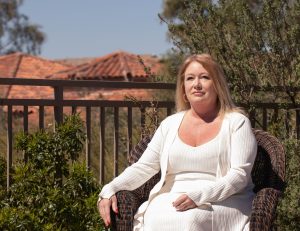- Slug: BC-CNS-Cyberbullying. 2,325 words.
- 4 photos and captions below.
- 5 MP3 sound clips below.
- Graphic here.
By HAILEY MENSIK
Cronkite News
PHOENIX – It was a Sunday night, about 11. Sheila Pott heard sirens wailing and then a knock on her front door.
A police officer stood outside, demanding her daughter’s phone. A day before, Pott had spoken at the funeral for her 15-year-old daughter, Audrie, who had committed suicide earlier that week after an assault.
Pott knew little about what caused the teen to take her own life, beyond a strange stream of apologetic Facebook messages from friends chiming from Audrie’s open laptop. But without a proper warrant, Pott refused to hand over the phone.
That unsettling visit was the first in what would become a yearlong investigation into what happened at a 2012 Labor Day weekend party in the Silicon Valley suburb of Saratoga, California. Three 16-year-old boys sexually assaulted Audrie at the party, according to news accounts and the website of a foundation established in her name. They also took photos of the attack and shared them with classmates.
“I don’t think she thought she could start over,” Pott said during a recent visit with family in Phoenix, nearly seven years after Audrie’s death.
Her mother worries that little has been done for parents and victims of cyberbullying, as more and more teens gain access to smartphones. She and bullying experts believe increased accessibility to Wi-Fi, smartphones with high quality cameras and social media platforms are transforming how teens torment each other.
Listen to Sheila Pott
In 2013, the year after Audrie Pott took her life, 47% of teens said they owned a smartphone, according to the Pew Research Center.
In 2018, that number rose to 95%, and 45% said they’re on the phone almost constantly. Favorite online platforms for teens today include YouTube, Instagram and Snapchat.
An increase in teen suicides and first lady Melania Trump’s anti-cyberbullying campaign have brought the issue to national attention, although no federal laws exist to fight it. The First Amendment often protects it as free speech, legal experts say.
Efforts are underway in Arizona to at least curb parents’ fears, such as a new BullyBlocker mobile app from researchers at Arizona State University. Public officials also are working to educate teens about their mental health and digital citizenship and how a simple “like” or share could make them a bully’s accomplice.
Anonymity and the rise of the nerds
Deborah Hall, a psychologist and researcher at ASU, said that today’s cyberbullies no longer rely on chat-based venues, such as texting or instant messages. Instead, social media platforms, sometimes used anonymously, are employed to strengthen mob mentalities and the shame of victims.
“If I were a teenager and someone were to post an embarrassing picture of me online, that would you know, be pretty devastating,” Hall said. “But if I then knew it had been shared by 30 other people or I saw 500 likes on it, that’s going to magnify the impact of that single bullying message in a way that really hasn’t been understood yet.”
Anonymous accounts play a large role in cyberbullying’s pervasiveness, she said. People who, in another era, would be bullied themselves now have the tools to be the bullies.
Traditional face-to-face bullying usually entails a power differential, such as physical size or status status, but such things are insignificant from behind a screen, she said.
“In some ways, it sort of leveled the playing field in terms of who perpetrates bullying,” she said. “We’re seeing the type of people who historically were disinclined or had a relatively low likelihood of bullying someone in a face-to-face interaction, actually be much more likely to bully online.”
Listen to Deborah Hall
She also said that when people speak and act as groups online, they often behave in ways they never would individually.
“There’s not that sense of personal responsibility,” she said.
Bullied on Snapchat for disabilities
In a 2018 case in the Phoenix neighborhood of Ahwatukee Foothills, two students took videos of a classmate with disabilities while he spoke in front of the class and used a urinal in the restroom, then shared them on Snapchat, according to the student’s mother, Amanda Steele.
Because her son, Jordan, was older than 18, it wasn’t considered child pornography – despite the explicit content, she said.
Administrators at Mountain Pointe High School told her about the situation immediately and listened to her concerns, but she wasn’t pleased with the 10-day suspensions given to the bullies, a boy and a girl. The family pushed for the bullies to be prosecuted, but not without hesitation.
“I was once 15, and I know things weren’t always the greatest and everyone makes mistakes,” Steele said. “But I think this was a mistake that they need to at least understand the consequences of what they’ve done.”
Listen to Amanda Steele
Steele said the incident occurred in November, but it wasn’t until late January that the Phoenix Police Department recommended harassment charges against the bullies, who are now back at school. She wants them charged with surreptitious filming.
An issue for schools or the courts?
Although the Steele family felt some comfort in the schools’ response, Audrie Pott’s mother criticized the reaction of school officials in California.
“There were a lot of things that were disappointing, and one was the way the courts treated it, and two was the way that the school really wanted to deny that it ever happened,” Sheila Pott said.
Pott said she wasn’t told about the sexual assault and images, although the school was investigating the incident in the days following Audrie’s death. When the school finally alerted her, her daughter’s body had been embalmed, destroying most evidence, she said.
“When you lose a student, and especially in the way that we lost Audrie, it’s a tragedy, especially for the family,” said Paul Robinson, principal of Saratoga High School. “But what the school suffered can never be compared to what the family suffered, and we realized that there were some things we could do to support our students more.”
The three boys admitted to the assault and were prosecuted in juvenile court, but the Pott family said the sentences were light. They’re trying to change minimum sentencing in California, along with making juvenile court proceedings more transparent.
Legal gray area
There is no federal law against bullying, whether in person or online. It’s dealt with at the state level, where laws and regulations require school districts to implement policies and procedures for investigating and responding to incidents. Arizona has such regulations.
Last year, Navajo Nation leaders passed a law criminalizing electronic activity that aids in stalking or harassment or contributes to someone’s death. Lawmakers hoped to reduce the rates of violence and suicide on the vast reservation, covering northeastern Arizona and parts of Utah and New Mexico.
Under Arizona law, cyberbullying can be deemed harassment, which is a misdemeanor, if it’s proven the bully repeatedly harassed another person online or kept them under online surveillance.
David Gingras, a Phoenix attorney who handles internet cases, said harassment – the charge brought against the two Mountain Pointe High School students – comes with few consequences other than an injunction forbidding further communication with the victim.
Listen to David Gingras
He also said amending the Constitution in light of tragedies is highly unlikely, similar to how increased gun violence hasn’t had much of an effect on protections for gun ownership.
“It’s exactly like the Second Amendment. Some people die because of guns,” Gingras said. “Some people might die because we have too much speech.”
“When we when we finally put together a statute that we think is going to be good to protect against cyberbullying, it’s near impossible to do that without running afoul of the First Amendment.”
Free-speech protections exclude obscene or defamatory content and actual threats or words proven to incite lawlessness, Gingras said, although definitions and examples remain highly subjective and ultimately are up to a judge or jury.
“Trying to create a new category of speech, beyond the limited exceptions that we have right now – speech that is hurtful to a child, or speech that results in someone killing themselves – those would be new categories, and I don’t know how you do it,” he said.
Shared images don’t always fall under free-speech protections, including photos that may depict child pornography or fall under the category of revenge porn – commonly defined as sharing a sexual photo or video of a former partner without consent and with intent to harm, harass or intimidate.
Gov. Doug Ducey signed a revenge porn law in 2016, making it a felony to share such intimate material without consent. A similar bill passed in 2014, but when a group of Arizona publishers, booksellers and photographers sued in federal court, a judge halted enforcement.
The American Civil Liberties Union, which argued the law criminalized protected speech, used the example of an artistic photographer with an anthology of nude images, or the publisher of their book, or the seller or a librarian.
Gingras is skeptical that new laws will curb online bullying.
“Passing a law would be like passing a law that says don’t shoot people,” he said.
An app to block bullies
In 2018, Instagram unveiled a “bully filter” meant to weed out harassing comments. It also allows users to report harassing messages or entire accounts.
But the question of who, if anyone, is responsible for teens being cyberbullied remains contested.
According to the Pew Research Center, 79% of teens think elected elected officials are doing only a fair or poor job of addressing cyberbullying, and 66% said the same of social media companies.
One local effort to at least help parents monitor their kids activity online, without violating their privacy, is underway at ASU’s West campus in Phoenix. Created by students and researchers in psychology and computer science, the BullyBlocker app, which is still in development mode, extracts data from a teen’s Facebook account.
Yasin Silva, project leader and professor, said it monitors comments, messages and posts that include triggering words or phrases based on details the parent provides for their child’s age, race or previous problems. It then calculates the likelihood of the child being cyberbullied, providing a ranking from 0 to 100 and directing parents to specific online resources.
Teens can pick and choose what their parents see, including a cyberbully’s screen name, to help maintain some level of privacy.
Silva acknowledged today’s teens aren’t on Facebook nearly as much as Instagram, Snapchat and YouTube. But when the project began in 2013, Facebook was popular, and had the most established protocol for data collection.
The project hit a bump last summer when Facebook was involved in a data collection scandal with Cambridge Analytica and changed its privacy policies.
“The app was in working condition, but because of the changes Facebook made, they modified a lot,” Silva said. “They have modified, significantly, the way to get access to this information.”
He said he’s working to obtain the permissions from Facebook to get the app up and running again. The team plans to modify it for use on Twitter, Instagram, Snapchat and other platforms popular with teens.
“All the architecture, we can really quickly adapt it for other social networks to extend the app to other platforms,” he said. “So that’s coming in the pipeline.”
He said similar apps exist, including Bark, which monitors Snapchat, Instagram and as many as 22 other platforms, and can even sort through mobile internet searches and texts. It’s $9 a month for a family subscription and free for schools.
Bark was created in response to school shootings, 16 of which it helped prevent, according to its website. It monitors students’ mobile communications on multiple platforms and alerts teachers upon detection of threats, suicidal messages, sexting and possible drug use.
Bullying starts in school
Gina Godbehere with the Maricopa County’s Attorney’s Office is tackling the issue with a program at schools around metro Phoenix. About every five days, she said, one Arizona teen commits suicide.
“The whole reason we started this program is because there were tragedies that were occuring in our local schools, and with every tragedy – whether it’s school shootings, suicide, bullying – we noticed that there were warning signs on social media,” Godbehere said.
Listen to Gina Godbehere
The annual conference Speak Up, Stand Up, Save a Life is for Arizona student leaders and administrators. It aims to educate teens about their behavior online, along with the warning signs a friend may be feeling depressed or suicidal. School leaders then implement the lessons through presentations at their own schools.
Another goal is motivating students to report their peers’ online behavior when it becomes worrisome.
“Their classmates are the first ones that are going to notice the warning signs, and a lot of those warning signs are on social media,” Godbehere said.
The program leaders try to break the mind-set that warning others about a problem is not being a snitch.
“Alerting people that coming forward is the right thing to do and it could save a life, that’s where we believe the future is,” Godbehere said.
Those moves resonate with Sheila Pott.
“She (Audrie) didn’t reach out to me, and tell me what happened, or a counselor or a teacher, she just tried to fix it over the course of a week. It just progressively got worse,” Pott said. “At that time, there were no mental health counselors on campus, so the only person she could go to was her guidance counselor.”
Pott said her family started a foundation in Audrie’s name and helped passed three laws in California named for Audrie Pott.
They also helped build a mental health facility on Audrie’s high school campus and the hiring of two full-time mental health counselors.
By April, about two years after the facility opened, the counselors had seen half of the schools’ 1,200 students, Pott said.
“That’s why they were adding a third counselor,” Pott said. “It kind of gives me chills to think that they’re really making an impact on these students.”
Subscribe to Cronkite News on YouTube.
For more stories from Cronkite News, visit cronkitenews.azpbs.org.
^_=




^_=